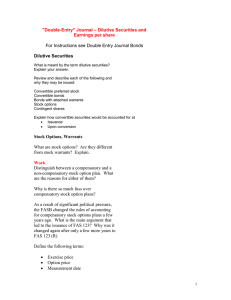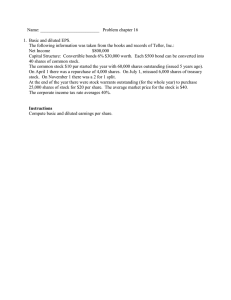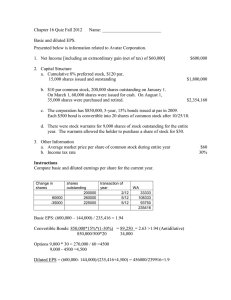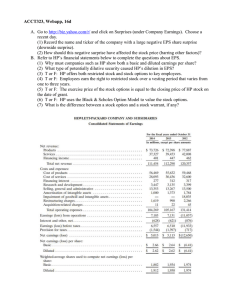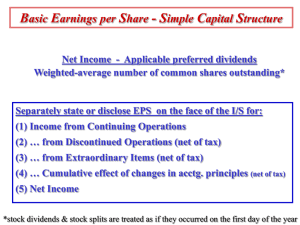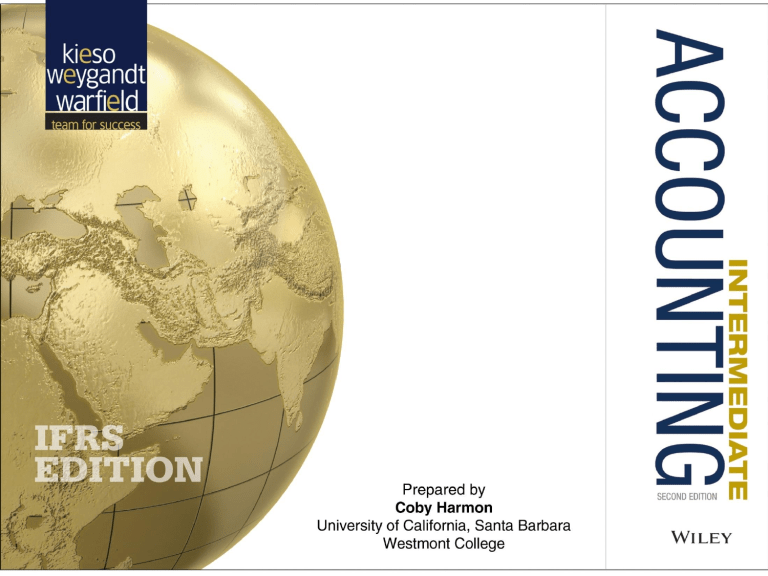
16-1 PREVIEW OF CHAPTER 16 Intermediate Accounting IFRS 2nd Edition Kieso, Weygandt, and Warfield 16-2 16 Dilutive Securities and Earnings Per Share LEARNING OBJECTIVES After studying this chapter, you should be able to: 1. Describe the accounting for the issuance, conversion, and retirement of convertible securities. 2. Explain the accounting for convertible preference shares. 3. Contrast the accounting for share warrants and for share warrants issued with other securities. 16-3 4. Describe the accounting for share compensation plans. 5. Discuss the controversy involving share compensation plans. 6. Compute earnings per share in a simple capital structure. 7. Compute earnings per share in a complex capital structure. DILUTIVE SECURITIES AND COMPENSATION PLANS Debt and Equity Should companies report these instruments as a liability or equity? Share Options 16-4 Convertible Securities Preference Shares LO 1 Convertible Debt Bonds which can be changed into other corporate securities are called convertible bonds. Benefit of a Bond (guaranteed interest and principal) + Privilege of Exchanging it for Shares (at the holder’s option) 16-5 LO 1 Convertible Debt Two main reasons corporations issue convertibles: To raise equity capital without giving up more ownership control than necessary. Obtain debt financing at cheaper rates. 16-6 LO 1 Convertible Debt Accounting for Convertible Debt Convertible debt is accounted for as a compound instrument. Companies use the “with-and-without” method to value compound instruments. ILLUSTRATION 16-1 Convertible Debt Components 16-7 LO 1 Convertible Debt Accounting for Convertible Debt Implementation of the with-and-without approach: 1. First, determine total fair value of convertible debt with both the liability and equity component. 2. Second, determine liability component by computing net present value of all contractual future cash flows discounted at the market rate of interest. 3. Finally, subtract liability component estimated in second step from fair value of convertible debt (issue proceeds) to arrive at the equity component. 16-8 LO 1 Convertible Debt Accounting at Time of Issuance Illustration: Roche Group (CHE) issues 2,000 convertible bonds at the beginning of 2015. The bonds have a four-year term with a stated rate of interest of 6 percent and are issued at par with a face value of €1,000 per bond (the total proceeds received from issuance of the bonds are €2,000,000). Interest is payable annually at December 31. Each bond is convertible into 250 ordinary shares with a par value of €1. The market rate of interest on similar non-convertible debt is 9 percent. 16-9 LO 1 Convertible Debt ILLUSTRATION 16-2 Time Diagram for Convertible Bond Accounting at Time of Issuance ILLUSTRATION 16-3 Fair Value of Liability Component of Convertible Bond ILLUSTRATION 16-4 Equity Component of Convertible Bond 16-10 LO 1 Convertible Debt Accounting at Time of Issuance ILLUSTRATION 16-3 Fair Value of Liability Component of Convertible Bond ILLUSTRATION 16-4 Equity Component of Convertible Bond Journal Entry Cash Bonds Payable Share Premium—Conversion Equity 16-11 2,000,000 1,805,606 194,394 LO 1 Convertible Debt Settlement of Convertible Bonds Repurchase at Maturity. If the bonds are not converted at maturity, Roche makes the following entry to pay off the convertible debtholders. Bonds Payable Cash 2,000,000 2,000,000 NOTE: The amount originally allocated to equity of €194,384 either remains in the Share Premium—Conversion Equity account or is transferred to the Share Premium—Ordinary account. 16-12 LO 1 Convertible Debt Settlement of Convertible Bonds Conversion of Bonds at Maturity. If the bonds are converted at maturity, Roche makes the following entry. Share Premium—Conversion Equity Bonds Payable Share Capital—Ordinary Share Premium—Ordinary 194,394 2,000,000 500,000 1,694,394 NOTE: The amount originally allocated to equity of €194,384 is transferred to the Share Premium—Ordinary account. 16-13 LO 1 Convertible Debt Settlement of Convertible Bonds Conversion of Bonds before Maturity. 16-14 ILLUSTRATION 16-5 Convertible Bond Amortization Schedule LO 1 Convertible Debt Settlement of Convertible Bonds Conversion of Bonds before Maturity. Assuming that Roche converts its bonds into ordinary shares on December 31, 2016. Share Premium—Conversion Equity Bonds Payable Share Capital—Ordinary Share Premium—Ordinary 194,374 1,894,464 500,000 1,588,838 NOTE: The amount originally allocated to equity (€194,374) is transferred to the Share Premium—Ordinary account. 16-15 LO 1 Convertible Debt Settlement of Convertible Bonds Repurchase before Maturity. Roche determines the fair value of the liability component of the convertible bonds at December 31, 2016, and then subtracts the fair value of the convertible bond issue (including the equity component) to arrive at the value of the equity. Then, 1. The difference between the consideration allocated to the liability component and the carrying amount of the liability is recognized as a gain or loss, and 2. The amount of consideration relating to the equity component is recognized (as a reduction) in equity. 16-16 LO 1 Convertible Debt Settlement of Convertible Bonds Repurchase before Maturity. Assume: 16-17 Fair value of the convertible debt (including both liability and equity components), based on market prices at December 31, 2016, is €1,965,000. The fair value of the liability component is €1,904,900. This amount is based on computing the present value of a nonconvertible bond with a two-year term (which corresponds to the shortened time to maturity of the repurchased bonds.) LO 1 Convertible Debt Settlement of Convertible Bonds First, determine the gain or loss on the liability component. ILLUSTRATION 16-6 Next, determine any adjustment to the equity. ILLUSTRATION 16-7 16-18 LO 1 Convertible Debt Settlement of Convertible Bonds ILLUSTRATION 16-6 & 7 Bonds Payable Journal Entry Share Premium—Conversion Equity 60,100 Loss on Repurchase 10,436 Cash 16-19 1,894,464 1,965,000 LO 1 Convertible Debt Induced Conversion 16-20 Issuer wishes to encourage prompt conversion. Issuer offers additional consideration, called a “sweetener,” to induce conversion. Sweetener is an expense of the period. LO 1 Convertible Debt Induced Conversion Illustration: Helloid, Inc. has outstanding $1,000,000 par value convertible debentures convertible into 100,000 ordinary shares ($1 par value). When issued, Helloid recorded Share Premium—Conversions Equity of $15,000. Helloid wishes to reduce its annual interest cost. To do so, Helloid agrees to pay the holders of its convertible debentures an additional $80,000 if they will convert. Assuming conversion occurs, Helloid makes the following entry. 16-21 LO 1 Convertible Debt Induced Conversion Illustration: Helloid makes the following entry. Conversion Expense 80,000 Share Premium—Conversion Equity 15,000 Bonds Payable Share Capital—Ordinary 100,000 Share Premium—Ordinary 915,000 Cash 16-22 1,000,000 80,000 LO 1 16 Dilutive Securities and Earnings Per Share LEARNING OBJECTIVES After studying this chapter, you should be able to: 1. Describe the accounting for the issuance, conversion, and retirement of convertible securities. 2. Explain the accounting for convertible preference shares. 3. Contrast the accounting for share warrants and for share warrants issued with other securities. 16-23 4. Describe the accounting for share compensation plans. 5. Discuss the controversy involving share compensation plans. 6. Compute earnings per share in a simple capital structure. 7. Compute earnings per share in a complex capital structure. Convertible Preference Shares Convertible preference shares include an option for the holder to convert preference shares into a fixed number of ordinary shares. Convertible preference shares are reported as part of equity. When preference shares are converted or repurchased, there is no gain or loss recognized. 16-24 LO 2 Convertible Preference Shares Illustration: Morse Company issues 1,000 convertible preference shares that have a par value of €1 per share. The shares were issued at a price of €200 per share. The journal entry to record this transaction is as follows. Cash (1,000 x €200) Share Capital—Preference (1,000 x €1) Share Premium—Conversion Equity 16-25 200,000 1,000 199,000 LO 2 Convertible Preference Shares Illustration: If each share is subsequently converted into 25 each ordinary shares (€2 par value) that have a fair value of €410,000, the journal entry to record the conversion is as follows. Share Capital—Preference Share Premium—Conversion Equity Share Capital—Ordinary (1,000 x 25 x €2) Share Premium—Ordinary 16-26 1,000 199,000 50,000 150,000 LO 2 Convertible Preference Shares Illustration: If the convertible preference shares are repurchased at their fair value instead of converted, Morse makes the following entry. Share Capital—Preference 1,000 Share Premium—Conversion Equity 199,000 Retained Earnings 210,000 Cash 410,000 Any excess paid above the book value of the convertible preference shares is often debited to Retained Earnings. 16-27 LO 2 16 Dilutive Securities and Earnings Per Share LEARNING OBJECTIVES After studying this chapter, you should be able to: 1. Describe the accounting for the issuance, conversion, and retirement of convertible securities. 2. Explain the accounting for convertible preference shares. 3. Contrast the accounting for share warrants and for share warrants issued with other securities. 16-28 4. Describe the accounting for share compensation plans. 5. Discuss the controversy involving share compensation plans. 6. Compute earnings per share in a simple capital structure. 7. Compute earnings per share in a complex capital structure. Share Warrant Warrants are certificates entitling the holder to acquire shares at a certain price within a stated period. Normally arises under three situations: 1. To make the security more attractive. 2. Existing shareholders have a preemptive right to purchase ordinary shares. 3. To executives and employees as a form of compensation. 16-29 LO 3 Share Warrant Share Warrants Issued with Other Securities Warrants issued with other securities are basically long-term options to buy ordinary shares at a fixed price. 16-30 Generally, the life of warrants is five years, occasionally 10 years. Company should use the with-and-without method to allocate the proceeds between the two components. LO 3 Share Warrant Illustration: At one time, Siemens AG (DEU) issued bonds with detachable five-year warrants. Assume that the five-year warrants provide the option to buy one ordinary share (par value €5) at €25. At the time, an ordinary share of Siemens was selling for approximately €30. These warrants enabled Siemens to price its bond offering (with a €10,000,000 face value) at par with an 8¾ percent yield (quite a bit lower than prevailing rates at that time). In this example, Siemens was able to sell the bonds plus the warrants for €10,200,000. To account for the proceeds from this sale, Siemens uses the with-and-without method. Using this approach, Siemens determines the present value of the future cash flows related to the bonds, which is €9,707,852. 16-31 LO 3 Share Warrant Illustration: Using this approach, Siemens determines the present value of the future cash flows related to the bonds, which is €9,707,852. ILLUSTRATION 16-8 Equity Component of Security Issue The bonds sell at a discount. Siemens records the sale as follows. Cash Bonds Payable 16-32 9,705,852 9,705,852 LO 3 Share Warrant Illustration: Using this approach, Siemens determines the present value of the future cash flows related to the bonds, which is €9,707,852. ILLUSTRATION 16-8 Equity Component of Security Issue In addition, Siemens sells warrants and make the following entry. Cash Share Premium-Share Warrants 16-33 492,148 492,148 LO 3 Share Warrant Illustration: Assuming investors exercise all 10,000 warrants (one warrant per one ordinary share), Siemens makes the following entry. Cash (10,000 x €25) 250,000 Share Premium—Share Warrants 492,148 Share Capital—Ordinary (10,000 x €5) Share Premium—Ordinary 16-34 50,000 692,148 LO 3 Share Warrant Rights to Subscribe to Additional Shares Share Rights - existing stockholders have the right (preemptive privilege) to purchase newly issued shares in proportion to their holdings. 16-35 Price is normally less than current market value. Companies make only a memorandum entry. LO 3 Share Warrant Share Compensation Plans Share Option - gives key employees option to purchase ordinary shares at a given price over extended period of time. Effective compensation programs are ones that: 1. Base compensation on performance. 2. Motivate employees. 3. Help retain executives and recruit new talent. 4. Maximize employee’s after-tax benefit and minimize employer’s after-tax cost. 5. Use performance criteria over which employee has control. 16-36 LO 3 Share Warrant The Major Reporting Issue IASB guidelines requires companies to recognize compensation cost using the fair-value method. Under the fair-value method, companies use acceptable optionpricing models to value the options at the date of grant. 16-37 LO 3 16 Dilutive Securities and Earnings Per Share LEARNING OBJECTIVES After studying this chapter, you should be able to: 1. Describe the accounting for the issuance, conversion, and retirement of convertible securities. 2. Explain the accounting for convertible preference shares. 3. Contrast the accounting for share warrants and for share warrants issued with other securities. 16-38 4. Describe the accounting for share compensation plans. 5. Discuss the controversy involving share compensation plans. 6. Compute earnings per share in a simple capital structure. 7. Compute earnings per share in a complex capital structure. Accounting for Share Compensation Share Option Plans Two main accounting issues: 1. How to determine compensation expense. 2. Over what periods to allocate compensation expense. 16-39 LO 4 Accounting for Share Compensation Determining Expense Companies compute total compensation expense based on the fair value of the options expected to vest on the date they grant the options to the employee(s) (i.e., the grant date). Allocating Compensation Expense Recognize compensation expense in the periods in which employees perform the service—the service period. 16-40 LO 4 Accounting for Share Compensation Illustration: On November 1, 2014, the shareholders of Chen Company approve a plan that grants the company’s five executives options to purchase 2,000 shares each of the company’s ¥100 par value ordinary shares. The company grants the options on January 1, 2015. The executives may exercise the options at any time within the next 10 years. The option price per share is ¥6,000, and the market price of the shares at the date of grant is ¥7,000 per share. Under the fair value method, the company computes total compensation expense by applying an acceptable fair value option-pricing model (such as the BlackScholes option-pricing model). To keep this illustration simple, we assume that the fair value option-pricing model determines Chen’s total compensation expense to be ¥22,000,000. 16-41 LO 4 Accounting for Share Compensation Basic Entries: Assume that the expected period of benefit is two years, starting with the grant date. Chen would record the transactions related to this option contract as follows. Dec. 31, 2015 Compensation Expense 11,000,000 * Share Premium—Share Options 11,000,000 Dec. 31, 2016 Compensation Expense Share Premium—Share Options 11,000,000 11,000,000 * (¥22,000,000 ÷ 2) 16-42 LO 4 Accounting for Share Compensation Exercise. If Chen’s executives exercise 2,000 of the 10,000 options (20 percent of the options) on June 1, 2018 (three years and five months after date of grant), the company records the following journal entry. June 1, 2018 Cash (2,000 x ¥6,000) Share Premium—Share Options Share Capital—Ordinary (2,000 x ¥100) Share Premium—Ordinary 16-43 12,000,000 4,400,000 200,000 16,200,000 LO 4 Accounting for Share Compensation Expiration. If Chen’s executives fail to exercise the remaining share options before their expiration date, the company records the following at the date of expiration. Jan. 1, 2025 Share Premium—Share Options 17,600,000 * Share Premium—Expired Share Options 17,600,000 * (¥22,000,000 x 80%) 16-44 LO 4 Accounting for Share Compensation Adjustment. Once the total compensation is measured at the date of grant, can it be changed in future periods? Depends on whether the adjustment is caused by a 16-45 service or market condition. LO 4 Accounting for Share Compensation Restricted Shares Restricted-share plans transfer shares to employees, subject to an agreement that the shares cannot be sold, transferred, or pledged until vesting occurs. Major Advantages: 1. Shares never becomes completely worthless. 2. Shares generally results in less dilution to existing shareholders. 3. Shares better aligns employee incentives with company incentives. 16-46 LO 4 Accounting for Share Compensation Restricted Shares Example: On January 1, 2015, Ogden Company issues 1,000 restricted shares to its CEO, Christie DeGeorge. Ogden’s shares have a fair value of $20 per share on January 1, 2015. Additional information is as follows. Service period related to the restricted shares is five years. Vesting occurs if DeGeorge stays with the company for a five- year period. Par value of the stock is $1 per share. Ogden makes the following entry on the grant date (January 1, 2015). 16-47 LO 4 Accounting for Share Compensation Restricted Shares Example: Ogden makes the following entry on the grant date (January 1, 2015). Unearned Compensation Share Capital--Ordinary (1,000 x $1) Share Premium--Ordinary (1,000 x $19) 20,000 1,000 19,000 Unearned Compensation represents the cost of services yet to be performed, which is not an asset. Reported in equity in the statement of financial position, as a contra equity account 16-48 LO 4 Accounting for Share Compensation Restricted Shares Example: Record the journal entry at December 31, 2015, Ogden records compensation expense. Compensation expense Unearned compensation 4,000 4,000 Ogden records compensation expense of $4,000 for each of the next four years (2016, 2017, 2018, and 2019). 16-49 LO 4 Accounting for Share Compensation Restricted Shares Exam: Assume that DeGeorge leaves on February 3, 2017(before any expense has been recorded during 2017). The entry to record this forfeiture is as follows Share Capital--Ordinary Share Premium--Ordinary Compensation Expense ($4,000 x 2) Unearned Compensation 16-50 1,000 19,000 8,000 12,000 LO 4 Accounting for Share Compensation Employee Stock-Purchase Plans (ESPPs) 16-51 Generally permit all employees to purchase shares at a discounted price for a short period of time. Considered compensatory and should be recorded as expense over the service period. LO 4 Accounting for Share Compensation Illustration: Masthead Company offers all its 1,000 employees the opportunity to participate in an employee share-purchase plan. Under the terms of the plan, the employees are entitled to purchase 100 ordinary shares (par value £1 per share) at a 20 percent discount. The purchase price must be paid immediately upon acceptance of the offer. In total, 800 employees accept the offer, and each employee purchases on average 80 shares. That is, the employees purchase a total of 64,000 shares. The weightedaverage market price of the shares at the purchase date is £30 per share, and the weighted-average purchase price is £24 per share. 16-52 LO 4 Accounting for Share Compensation Illustration: The entry to record this transaction is as follows. Cash (64,000 x £24) Compensation Expense [64,000 x (£30 - £24)] Share Capital—Ordinary (64,000 x £1) Share Premium—Ordinary 1,536,000 384,000 64,000 1,856,000 The IASB indicates that there is no reason to treat broad-based employee share plans differently from other employee share plans. 16-53 LO 4 Accounting for Share Compensation Disclosure of Compensation Plans Company with one or more share-based payment arrangements must disclose: 1. Nature and extent of share-based payment arrangements that existed during the period. 2. How the fair value of the goods and services received, or the fair value of the equity instruments granted during the period, was determined. 3. Effect of share-based payment transactions on the company’s net income (loss) during the period and on its financial position. 16-54 LO 4 16 Dilutive Securities and Earnings Per Share LEARNING OBJECTIVES After studying this chapter, you should be able to: 1. Describe the accounting for the issuance, conversion, and retirement of convertible securities. 2. Explain the accounting for convertible preference shares. 3. Contrast the accounting for share warrants and for share warrants issued with other securities. 16-55 4. Describe the accounting for share compensation plans. 5. Discuss the controversy involving share compensation plans. 6. Compute earnings per share in a simple capital structure. 7. Compute earnings per share in a complex capital structure. Debate over Share-Based Accounting The IASB faced considerable opposition when it proposed the fair value method for accounting for share options. This is not surprising, given that the fair value method results in greater compensation costs relative to the intrinsic-value model. Transparent financial reporting—including recognition of sharebased expense—should not be criticized because companies will report lower income. If we write standards to achieve some social, economic, or public policy goal, financial reporting loses its credibility. 16-56 LO 5 16 Dilutive Securities and Earnings Per Share LEARNING OBJECTIVES After studying this chapter, you should be able to: 1. Describe the accounting for the issuance, conversion, and retirement of convertible securities. 2. Explain the accounting for convertible preference shares. 3. Contrast the accounting for share warrants and for share warrants issued with other securities. 16-57 4. Describe the accounting for share compensation plans. 5. Discuss the controversy involving share compensation plans. 6. Compute earnings per share in a simple capital structure. 7. Compute earnings per share in a complex capital structure. COMPUTING EARNINGS PER SHARE Earnings per share - income earned by each ordinary share. 16-58 Companies report earnings per share only for ordinary shares. When the income statement contains discontinued operations, companies are required to report earnings per share from continuing operations and net income on the face of the income statement. ILLUSTRATION 16-12 Income Statement Presentation of EPS Components LO 6 Earnings Per Share—Simple Capital Structure Simple Structure Only ordinary shares; no potentially ordinary shares upon conversion or exercise. Complex Structure Includes securities (potential ordinary shares) that could have a dilutive effect on earnings per ordinary share. 16-59 “Dilutive” means the ability to influence EPS in a downward direction. LO 6 EPS—Simple Capital Structure Preference Share Dividends Subtracts the current-year preference share dividend from net income to arrive at income available to ordinary shareholders. Preference dividends are subtracted on cumulative preference shares, whether declared or not. 16-60 ILLUSTRATION 16-13 Formula for Computing Earnings per Share LO 6 EPS—Simple Capital Structure Weighted-Average Number of Shares Outstanding Companies must weight the shares by the fraction of the period they are outstanding. When share dividends or share splits occur, companies need to restate the shares outstanding before the share dividend or split. 16-61 LO 6 EPS—Simple Capital Structure Illustration: Sabrina Company has the following changes in its ordinary shares during the year. ILLUSTRATION 16-16 Sabrina computes the weighted-average number of shares outstanding as follows. 16-62 LO 6 ILLUSTRATION 16-16 Illustration 16-17 16-63 ILLUSTRATION 16-17 Weighted-Average Number of Shares Outstanding—Share Issue and Share Dividend LO 6 16 Dilutive Securities and Earnings Per Share LEARNING OBJECTIVES After studying this chapter, you should be able to: 1. Describe the accounting for the issuance, conversion, and retirement of convertible securities. 2. Explain the accounting for convertible preference shares. 3. Contrast the accounting for share warrants and for share warrants issued with other securities. 16-64 4. Describe the accounting for share compensation plans. 5. Discuss the controversy involving share compensation plans. 6. Compute earnings per share in a simple capital structure. 7. Compute earnings per share in a complex capital structure. EPS—Complex Capital Structure Complex Capital Structure exists when a corporation has convertible securities, options, warrants, or other rights that upon conversion or exercise could dilute earnings per share. Company reports both basic and diluted earnings per share. 16-65 LO 7 EPS—Complex Capital Structure Diluted EPS includes the effect of all potential dilutive ordinary shares that were outstanding during the period. ILLUSTRATION 16-22 Companies will not report diluted EPS if the securities in their capital structure are antidilutive. 16-66 LO 7 EPS—Complex Capital Structure Diluted EPS – Convertible Securities Measure the dilutive effects of potential conversion on EPS using the if-converted method. This method for a convertible bond assumes: 1. the conversion at the beginning of the period (or at the time of issuance of the security, if issued during the period), and 2. the elimination of related interest, net of tax. 16-67 LO 7 EPS—Complex Capital Structure Illustration: Mayfield Corporation has net income of £210,000 for the year and a weighted-average number of ordinary shares outstanding during the period of 100,000 shares. The basic earnings per share is therefore £2.10 (£210,000 4 100,000). The company has two convertible debenture bond issues outstanding. One is a 6 percent issue sold at 100 (total £1,000,000) in a prior year and convertible into 20,000 ordinary shares. Interest expense for the current year related to the liability component of this convertible bond is £62,000. The other is a 7 percent issue sold at 100 (total £1,000,000) on April 1 of the current year and convertible into 32,000 ordinary shares. Interest expense for the current year related to the liability component of this convertible bond is £80,000. The tax rate is 40 percent. 16-68 LO 7 EPS—Complex Capital Structure Basic EPS Net income = £210,000 Weighted-average shares = 100,000 16-69 = £2.10 LO 7 EPS—Complex Capital Structure When calculating Diluted EPS, begin with Basis EPS. Basic EPS 6% Debentures 7% Debentures £210,000 + £62,000 x (1 - .40) + £80,000 x (1 - .40) x 9/12 = 100,000 Basic EPS = 2.10 + 20,000 Effect on EPS = 1.86 + 24,000 Effect on EPS = 1.50 Diluted EPS = £1.97 16-70 LO 7 EPS—Complex Capital Structure Diluted EPS – Convertible Securities Other Factors The conversion rate on a dilutive security may change during the period in which the security is outstanding. In this situation, the company uses the most dilutive conversion rate available. For Convertible Preference Shares the company does not subtract preference dividends from net income in computing the numerator. Why not? Because for purposes of computing EPS, it assumes conversion of the convertible preference shares to outstanding ordinary shares. 16-71 LO 7 EPS—Complex Capital Structure Illustration (EPS with Preference Shares): On January 1, 2015, Lund Company issued €1,000,000 of 6% convertible preference shares were issued. Each €100 preference share is convertible into 5 ordinary shares of Lund. Lund’s net income in 2015 was €240,000, and its tax rate was 40%. The company had 100,000 ordinary shares outstanding throughout 2015. Instructions: Compute diluted earnings per share for 2015. 16-72 LO 7 EPS—Complex Capital Structure Illustration: Compute diluted EPS for 2015. When calculating Diluted EPS, begin with Basis EPS. Basic EPS Net income £240,000 – Pfd. Div. £60,000 * Weighted-average shares = 100,000 = £1.80 * £1,000,000 x 6% = £60,000 dividend 16-73 LO 7 EPS—Complex Capital Structure Illustration: Compute diluted EPS for 2015. When calculating Diluted EPS, begin with Basis EPS. Diluted EPS £240,000 – £60,000 + £60,000 100,000 + 50,000* Basic EPS = 1.80 16-74 Effect on EPS = 1.20 = £240,000 = 150,000 £1.60 * (10,000 x 5) LO 7 EPS—Complex Capital Structure Illustration (variation): Assume each share of preferred is convertible into 3 shares of common stock. Diluted EPS Basic = Diluted EPS £240,000 – £60,000 + £60,000 100,000 + 30,000* = £180,000 100,000 = Antidilutive £1.80 Basic EPS = 1.80 16-75 Effect on EPS = 2.00 * (10,000 x 3) LO 7 EPS—Complex Capital Structure Diluted EPS – Options and Warrants Measure the dilutive effects of potential conversion using the treasury-share method. This method assumes: 1. company exercises the options or warrants at the beginning of the year (or date of issue if later), and 2. that it uses those proceeds to purchase ordinary shares for the treasury. 16-76 LO 7 EPS—Complex Capital Structure Illustration: Kubitz Industries, Inc. has net income for the period of ₴220,000. The average number of shares outstanding for the period was 100,000 shares. Hence, basic EPS—ignoring all dilutive securities—is ₴2.20. The average number of shares related to options outstanding (although not exercisable at this time), at an option price of ₴20 per share, is 5,000 shares. The average market price of the ordinary shares during the year was ₴28. Compute EPS using the treasury-share method. 16-77 LO 7 EPS—Complex Capital Structure ILLUSTRATION 16-27 Computation of Earnings per Share—Treasury-Share Method 16-78 LO 7 EPS—Complex Capital Structure Contingently Issuable Shares Ordinary shares issuable for little or no cash consideration upon satisfaction of specified conditions in a contingent share agreement. Antidilution Revisited Ignore antidilutive securities in all calculations and in computing diluted earnings per share. 16-79 LO 7 EPS—Complex Capital Structure EPS Presentation and Disclosure A company should show per share amounts for: Income from continuing operations, Discontinued operations, and Net income. Per share amounts for a discontinued operation should be presented on the face of the income statement or in the notes to the financial statements. 16-80 LO 7 EPS Presentation and Disclosure ILLUSTRATION 16-29 EPS Presentation— Complex Capital Structure 16-81 ILLUSTRATION 16-30 EPS Presentation, with Discontinued Operations LO 7 Summary of EPS Computation ILLUSTRATION 16-32 Calculating EPS, Simple Capital Structure 16-82 LO 7 Summary of EPS Computation ILLUSTRATION 16-33 Calculating EPS, Complex Capital Structure 16-83 LO 7 GLOBAL ACCOUNTING INSIGHTS DILUTIVE SECURITIES AND EARNINGS PER SHARE Both the FASB and the IASB are working on a standard related to the distinction between liabilities and equity. The U.S. GAAP approach to account for certain dilutive securities, such as convertible debt and debt issued with share warrants, is different than IFRS. The accounting and disclosure requirements for accounting for share options and EPS computations are similar between U.S. GAAP and IFRS. 16-84 GLOBAL ACCOUNTING INSIGHTS Relevant Facts Similarities • U.S. GAAP and IFRS follow the same model for recognizing share-based compensation: The fair value of shares and options awarded to employees is recognized over the period to which the employees’ services relate. • Although the calculation of basic and diluted earnings per share is similar between U.S. GAAP and IFRS, the Boards are working to resolve the few minor differences in EPS reporting. One proposal in the FASB project concerns contracts that can be settled in either cash or shares. IFRS requires that share settlement must be used, while U.S. GAAP gives companies a choice. The FASB project proposes adopting the IFRS approach, thus converging U.S. GAAP and IFRS in this regard. 16-85 GLOBAL ACCOUNTING INSIGHTS Relevant Facts Differences • Under U.S. GAAP, all of the proceeds of convertible debt are recorded as long-term debt. Under IFRS, convertible bonds are “bifurcated”—separated into the equity component (the value of the conversion option) of the bond issue and the debt component. • Related to employee share-purchase plans, these plans under U.S. GAAP are often considered non-compensatory and therefore no compensation is recorded. However, certain conditions must exist before a plan can be considered non-compensatory. Under IFRS, all employee share-purchase plans are deemed to be compensatory; that is, compensation expense is recorded for the amount of the discount. 16-86 GLOBAL ACCOUNTING INSIGHTS Relevant Facts Differences • Modification of a share option results in the recognition of any incremental fair value under both U.S. GAAP and IFRS. However, if the modification leads to a reduction, U.S. GAAP permits the reduction. IFRS does not. • Other EPS differences relate to (1) the treasury-share method and how the proceeds from extinguishment of a liability should be accounted for, and (2) how to compute the weighted average of contingently issuable shares. 16-87 GLOBAL ACCOUNTING INSIGHTS On the Horizon The FASB has been working on a standard that will likely converge to IFRS in the accounting for convertible debt. Similar to the IASB, the FASB is examining the classification of hybrid securities; the IASB is seeking comment on a discussion document similar to the FASB Preliminary Views document, “Financial Instruments with Characteristics of Equity.” It is hoped that the Boards will develop a converged standard in this area. While U.S. GAAP and IFRS are similar as to the presentation of EPS, the Boards have been considering a project to resolve remaining differences related to earnings per share computations. 16-88 APPENDIX 16A ACCOUNTING FOR SHARE-APPRECIATION RIGHTS Stock-Appreciation Rights (SARs): 16-89 The company gives an executive the right to receive compensation equal to the share appreciation. Share appreciation is the excess of the market price of the stock at the date of exercise over a pre-established price. The company may pay the share appreciation in cash, shares, or a combination of both. The accounting for stock-appreciation rights depends on whether the company classifies the rights as equity or as a liability. LO 8 Explain the accounting for share-appreciation plans. APPENDIX 16A ACCOUNTING FOR SHARE-APPRECIATION RIGHTS SARS— SHARE-BASED EQUITY AWARDS Companies classify SARs as equity awards if at the date of exercise, the holder receives shares of stock from the company upon exercise. Holder receives shares in an amount equal to the share-price appreciation (the difference between the market price and the pre-established price). At the date of grant, the company determines a fair value for the SAR and then allocates this amount to compensation expense over the service period of the employees. 16-90 LO 8 APPENDIX 16A ACCOUNTING FOR SHARE-APPRECIATION RIGHTS SARS— SHARE-BASED LIABILITY AWARDS Companies classify SARs as liability awards if at the date of exercise, the holder receives a cash payment. Accounting: 1. Measure the fair value of the award at the grant date and accrue compensation over the service period. 2. Remeasure the fair value each reporting period, until the award is settled; adjust the compensation cost each period for changes in fair value pro-rated for the portion of the service period completed. 3. Once the service period is completed, determine compensation expense each subsequent period by reporting the full change in market price as an adjustment to compensation expense. 16-91 LO 8 APPENDIX 16A ACCOUNTING FOR SHARE-APPRECIATION RIGHTS Illustration: Brazil Hotels, Inc. establishes a share-appreciation rights plan on January 1, 2015. The plan entitles executives to receive cash at the date of exercise for the difference between the market price of the stock and the pre-established price of R$10 on 10,000 SARs. The fair value of the SARs on December 31, 2015, is R$3, and the service period runs for two years (2015–2016). Illustration 16A-1 indicates the amount of compensation expense to be recorded each period. 16-92 LO 8 APPENDIX 16A ACCOUNTING FOR SHARE-APPRECIATION RIGHTS ILLUSTRATION 16A-1 Brazil Hotels records compensation expense in the first year as follows. Compensation Expense Liability under Share-Appreciation Plan 16-93 15,000 15,000 LO 8 APPENDIX 16A ACCOUNTING FOR SHARE-APPRECIATION RIGHTS ILLUSTRATION 16-A1 The entry to record negative compensation expense in 2017 is as follows: Liability under Share-Appreciation Plan Compensation Expense 16-94 20,000 20,000 LO 8 APPENDIX 16A ACCOUNTING FOR SHARE-APPRECIATION RIGHTS ILLUSTRATION 16-A1 At December 31, 2017, the executives receive $50,000. Brazil would remove the liability with the following entry. Liability under Share-Appreciation Plan Cash 16-95 50,000 50,000 LO 8 APPENDIX 16B COMPREHENSIVE EARNINGS PER SHARE ILLUSTRATION 16B-1 Statement of Financial Position for Comprehensive Illustration 16-96 LO 9 Compute earnings per share in a complex situation. APPENDIX 16B COMPREHENSIVE EARNINGS PER SHARE ILLUSTRATION 16B-1 Statement of Financial Position for Comprehensive Illustration 16-97 LO 9 APPENDIX 16B COMPREHENSIVE EARNINGS PER SHARE Computation of Earnings per Share—Simple Capital Structure ILLUSTRATION 16B-2 Computation of Earnings per Share—Simple Capital Structure 16-98 LO 9 APPENDIX 16B COMPREHENSIVE EARNINGS PER SHARE DILUTED EARNINGS PER SHARE Steps for computing diluted earnings per share: 1. Determine, for each dilutive security, the per share effect assuming exercise/conversion. 2. Rank the results from Step 1 from smallest to largest earnings effect per share. 3. Beginning with the earnings per share based upon the weightedaverage of ordinary shares outstanding, recalculate earnings per share by adding the smallest per share effects from Step 2. Continue this process so long as each recalculated earnings per share is smaller than the previous amount. 16-99 LO 9 APPENDIX 16B COMPREHENSIVE EARNINGS PER SHARE The first step is to determine a per share effect for each potentially dilutive security. Options ILLUSTRATION 16B-3 Per Share Effect of Options (Treasury-Share Method), Diluted Earnings per Share 16-100 LO 9 APPENDIX 16B COMPREHENSIVE EARNINGS PER SHARE The first step is to determine a per share effect for each potentially dilutive security. A Bonds ILLUSTRATION 16B-4 Per Share Effect of Issue A Bonds (If-Converted Method), Diluted Earnings per Share 16-101 LO 9 APPENDIX 16B COMPREHENSIVE EARNINGS PER SHARE The first step is to determine a per share effect for each potentially dilutive security. B Bonds ILLUSTRATION 16B-5 Per Share Effect of Issue B Bonds (If-Converted Method), Diluted Earnings per Share 16-102 LO 9 APPENDIX 16B COMPREHENSIVE EARNINGS PER SHARE The first step is to determine a per share effect for each potentially dilutive security. Preference Shares ILLUSTRATION 16B-6 Per Share Effect of 10% Convertible Preference Shares (If-Converted Method), Diluted Earnings per Share 16-103 LO 9 APPENDIX 16B COMPREHENSIVE EARNINGS PER SHARE The first step is to determine a per share effect for each potentially dilutive security. Ranking ILLUSTRATION 16B-7 Ranking of Per Share Effects (Smallest to Largest), Diluted Earnings per Share 16-104 LO 9 APPENDIX 16B COMPREHENSIVE EARNINGS PER SHARE The next step is to determine earnings per share giving effect to the ranking. Recomputation of EPS Using Incremental Effect of Options The effect of the options is dilutive. 16-105 ILLUSTRATION 16B-8 LO 9 APPENDIX 16B COMPREHENSIVE EARNINGS PER SHARE The next step is to determine earnings per share giving effect to the ranking. Recomputation of EPS Using Incremental Effect of 8% Convertible Bonds The effect of the 8% convertible bonds is dilutive. 16-106 ILLUSTRATION 16B-9 LO 9 APPENDIX 16B COMPREHENSIVE EARNINGS PER SHARE The next step is to determine earnings per share giving effect to the ranking. Recomputation of EPS Using Incremental Effect of 10% Convertible Bonds The effect of the 10% convertible bonds is dilutive. 16-107 ILLUSTRATION 16B-10 LO 9 APPENDIX 16B COMPREHENSIVE EARNINGS PER SHARE The next step is to determine earnings per share giving effect to the ranking. Recomputation of EPS Using Incremental Effect of 10% Convertible Preference Shares The effect is NOT dilutive. 16-108 ILLUSTRATION 16B-11 LO 9 APPENDIX 16B COMPREHENSIVE EARNINGS PER SHARE Finally, Webster Corporation’s disclosure of earnings per share on its income statement. ILLUSTRATION 16B-12 Income Statement Presentation, EPS 16-109 LO 9 APPENDIX 16B COMPREHENSIVE EARNINGS PER SHARE Assume that Barton Company provides the following information. ILLUSTRATION 16B-13 Barton Company Data Basic and Diluted EPS ILLUSTRATION 16B-14 16-110 COPYRIGHT Copyright © 2015 John Wiley & Sons, Inc. All rights reserved. Reproduction or translation of this work beyond that permitted in Section 117 of the 1976 United States Copyright Act without the express written permission of the copyright owner is unlawful. Request for further information should be addressed to the Permissions Department, John Wiley & Sons, Inc. The purchaser may make back-up copies for his/her own use only and not for distribution or resale. The Publisher assumes no responsibility for errors, omissions, or damages, caused by the use of these programs or from the use of the information contained herein. 16-111


